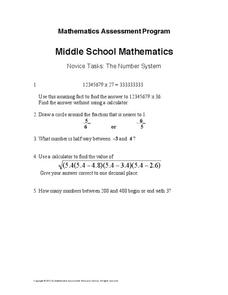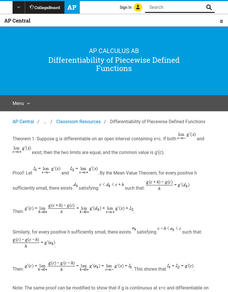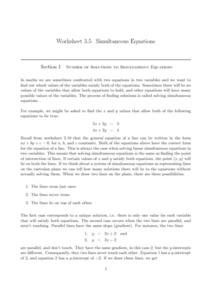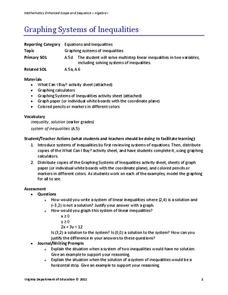Mathematics Assessment Project
The Number System
Count this assessment in the "use" pile. Middle schoolers solve a set of five problems in the seventh and eighth grade number system domains. All problems are in pure mathematics with no applications.
College Board
Differentiability of Piecewise Defined Functions
Differentiable or not, that is the question. An informational website gives two theorems on the differentiability of piecewise functions at their endpoints. It goes on to apply the theorems to present two solution methods to a past AP®...
Curated OER
Pollution and Environmental Studies- Daily Water Use
In this environmental studies worksheet, students create a data table to discover how much water each person uses on a daily basis and what it is used for. They complete a post activity to make and test solutions for pollution using a...
Curated OER
Worksheet 3.5 Simultaneous Equations
For this simultaneous equations worksheet, students solve and complete 7 various types of problems. First, they solve graphically the system of equations shown. Then, students find the number of solutions that each pairs of equations...
Mathematics Assessment Project
Solving Linear Equations in One Variable
A thorough and professional appearance characterizes a lesson on linear equations. Maturing mathematicians are taught to identify and exemplify linear equations with a single variable. They also classify equations according to the number...
Baylor College
Neural Network Signals
Using a simple circuit with the battery representing the brain, future physiologists test to see which solutions conduct electrical "nerve impulses." Enlighten learners with plentiful information on electric signals in the nervous system...
Baylor College
Moving Air
In lab groups, young scientists place aluminum cans with a bubble-solution cap into different temperatures of water to see what size of bubble dome forms. As part of an atmosphere unit in preparation for learning about convection...
Mt. San Antonio Collage
Quadratic Equations and Their Applications
Show high schoolers there is more to quadratic functions than just formulas and parabolas. Connect the math to realistic application problems with a resource that has learners consider such situations as a ball hit in the air, the...
Cornell University
Energy Changes in Chemical Reactions
The heat of solution measures how much thermal energy a dissolving substance consumes or gives off. The experiment demonstrates both endothermic and exothermic reactions. Scholars dissolve several substances, measure the temperature...
Curated OER
No Child Left Inside Lessons
The benefits of taking students outside for outdoor activities and lessons can be substantial for everyone.
Curated OER
Points of Intersection
Young scholars solve systems of equations. In this solving systems of equations lesson, students look for the intersection of the two lines in the system. Young scholars solve systems that have one solution, no solution, and...
Virginia Department of Education
Graphing Systems of Inequalities
Apply systems of inequalities to a real-world problem. Here, scholars learn to graph solutions to systems of linear inequalities. To finish the lesson, they solve a problem involving burgers and cheeseburgers using a system of inequalities.
Curated OER
Graphing Systems of Equations
In this systems of equations worksheet, students use graphs to solve systems of equations. They determine if the equation contains one solution, no solution, or many solutions. This one-page worksheet contains ten problems.
Illustrative Mathematics
Solving Two Equations in Two Unknowns
More than just a one-problem resource, learners must explain their answer and incorporate a writing component to mathematical thinking. The resource also includes an explanation of the solution to help with the reasoning.
Curated OER
Graphing Linear Functions
Students practice solving systems of linear equations using the substitution and elimination methods. They determine if the system has one, infinite or no solution. Students also graph the linear equations.
Curated OER
Middle Grades Math: Balancing Equations
Learners solve linear equations. By observing the graph of each side of an equation using the TI-nspire graphing calculator, your class gains insight into solutions, as well as balancing equations and transforming linear equations....
Illustrative Mathematics
Puzzle Times
Give your mathematicians this set of data and have them create a dot plot, then find mean and median. They are asked to question the values of the mean and median and decide why they are not equal. Have learners write their answers or...
Illustrative Mathematics
Selling Computers
A quick activity to test your learners' knowledge of percent increase. When an electronic store needs a 30% increase in computer sales, your mathematicians must calculate how many computers they need to sell next month.
Illustrative Mathematics
Traffic Jam
Help your learners understand dividing with fractions by using these methods to solve. Chose from two different number lines or linker cubes. This practices "how many groups?" style division problems which help them comprehend why...
Curated OER
Substitution
In this substitution worksheet, 9th graders solve and complete 15 different problems that include various systems of equations. First, they use substitution to solve each system of equations. Then, students state whether the equation has...
Illustrative Mathematics
Shrinking
Is Aunt Nancy shrinking? Find out by calculating with the average height women lose each year. The activity practices multiplying and dividing with decimals and rounding the final answer.
Illustrative Mathematics
Comparing Years
Who knew that the Egyptian, Julian, and Gregorian year were different lengths? Your mathematicians will! They will have to calculate the difference between the years in seconds and find the percent change. Using dimensional analysis,...
Illustrative Mathematics
Chess Club
When the membership in a chess club changes, it is your mathematicians' job to find out how many boys and girls are attending and the percent change from last year. The activity provides a great compound problem finding the different...
Noyce Foundation
Double Down
Double the dog ears, double the fun. Five problems provide increasing challenges with non-linear growth. Topics include dog ears, family trees and population data, and geometric patterns.























